Digital Posters
Prostate: Methods
ISMRM & SMRT Annual Meeting • 15-20 May 2021

| Concurrent 5 | 17:00 - 18:00 |
 |
4085.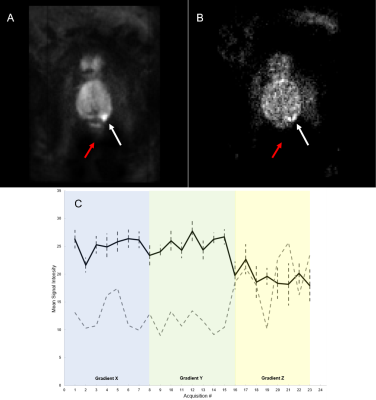 |
Directional and Inter-acquisition Variability in DWI (DAVID)
Jay M. Pittman1,2, Aritrick Chatterjee1,2, Teodora Szasz3, Grace Lee1,2, Mihai Giurcanu4, Milica Medved1,2, Ambereen Yousuf1,2, Ajit Devaraj5, Aytekin Oto1,2, and Gregory S. Karczmar1,2
1Radiology, The University of Chicago, Chicago, IL, United States, 2Sanford J. Grossman Center of Excellence in Prostate Imaging and Image Guided Therapy, The University of Chicago, Chicago, IL, United States, 3Research Computing Center, The University of Chicago, Chicago, IL, United States, 4Department of Public Health Sciences, The University of Chicago, Chicago, IL, United States, 5Philips Research North America, Cambridge, MA, United States
Diffusion Weighted Imaging (DWI) MRI detects prostate cancers but is very sensitive to motion artifacts. There has been little quantitative evaluation of variability to guide clinical use of DWI. We found very high variability between individual acquisitions used for averaging at high b-values (% ranges of 74.08% - 115.56% in cancers and 53.53% - 159.91% in normal prostate tissue), primarily due to motion during diffusion-sensitizing gradients. High signals in cancer voxels appear in some acquisitions but not others. Therefore, standard averaging can obscure cancers. We propose alternative methods for combining information from individual images at each b-value to maximize diagnostic accuracy.
|
||
4086.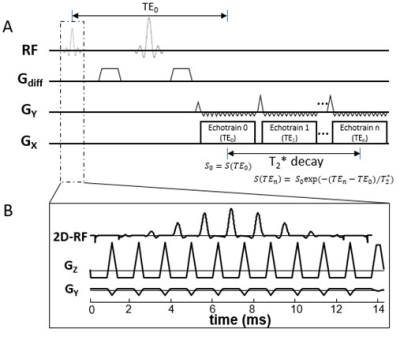 |
Multi-Readout Diffusion-Weighted Imaging for Studying Coupling between Apparent Diffusion Coefficient and Echo Time
Kaibao Sun1, Guangyu Dan1,2, Zheng Zhong1,2, and Xiaohong Joe Zhou1,2,3
1Center for MR Research, University of Illinois at Chicago, Chicago, IL, United States, 2Department of Bioengineering, University of Illinois at Chicago, Chicago, IL, United States, 3Departments of Radiology and Neurosurgery, University of Illinois at Chicago, Chicago, IL, United States
The dependence of apparent diffusion coefficient (ADC) on echo time (TE) has been observed in a number of biological tissues. Such coupling can be exploited to extract tissue microstructural information. We herein introduce a time-efficient sequence that is capable of studying the interplay between ADC and TE. The sequence incorporated multiple echo-train readouts into diffusion-weighted echo planar imaging, together with a 2D RF excitation pulse to reduce the FOV, thereby allowing multiple effective TEs in an acquisition. With this sequence, ADCs were evaluated at three TEs and T2*s at three b-values. The proposed technique has been demonstrated in the prostate.
|
|||
4087.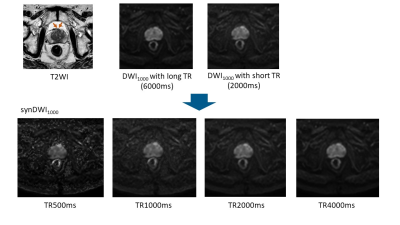 |
Synthetic DWI in prostate
Yu Ueda1, Tsutomu Tamada2, Makoto Obara1, Tetsuo Ogino1, Daisuke Morimoto-Ishikawa3, Hiroyasu Sanai2, Koji Yoshida2, Ayumu Kido2, Tomoko Hyodo4, Kazunari Ishii4, Masami Yoneyama1, and Marc Van Cauteren5
1Philips Japan, Tokyo, Japan, 2Department of Radiology, Kawasaki Medical School, Okayama, Japan, 3Radiology Center, Kindai University Hospital, Osaka, Japan, 4Department of Radiology, Kindai University, Osaka, Japan, 5BIU MR Asia Pacific, Philips Healthcare, Tokyo, Japan
The usefulness of short TR DWI in prostate has been reported. However, care should be taken when setting TR as DWI with shorter TR suffers from low SNR. It would be beneficial to generate an additional DWI with shorter TR (e.g. 1000ms) from DWIs with two different TR (e.g. conventional [long] and short TR such as 6000 and 2000ms). The synthetic DWI at b = 1000 s/mm2 (DWI1000) with shorter TR of 1000ms calculated from DWIs with TR of 6000 and 2000ms had a tendency to show better diffusion contrast compared to the real-acquired DWI1000 with long TR of 6000ms.
|
|||
4088.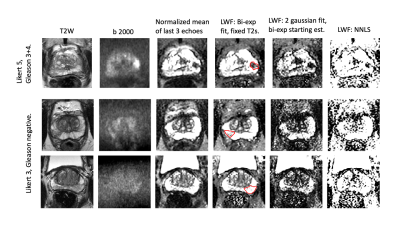 |
Rapid fitting of Luminal Water Fraction in Prostate MRI
David Atkinson1, Fiona Gong1, Giorgio Brembilla1, and Shonit Punwani1
1Centre for Medical Imaging, University College London, London, United Kingdom
Quantification of luminal water components provides tissue information in prostate MRI. The luminal water fraction (LWF) summarizes the amount of ‘luminal’, or longer T2 material in a distribution of tissue T2s. The parameters of this T2 distribution are found by fitting to the MR signal acquired from a multiple echo sequence. Iterative fitting of T2 distributions can be slow and different T2 distributions can give similar fits to data. The division into long and short T2 tissue for LWF calculations suggests that a simpler model may be effective. Two rapid alternative fits are presented.
|
|||
4089. |
Prostate MRI at 3-T: clinical impact of ultra-high b value (3,000 s/mm2) diffusion-weighted MR imaging compared to high b value of 2,000 s/mm2
Ayumu Kido1, Tsutomu Tamada1, Yu Ueda2, Masami Yoneyama2, and Akira Yamamoto1
1Radiology, Kawasaki Medical School, Okayama, Japan, 2Philips Japan, Tokyo, Japan
High b value DWI (b2000) shows insufficient image contrast between benign and malignant tissues and much overlap between ADCs of low grade and those of high-grade prostate cancers (PCs). Forty-nine patients with PC underwent multiparametric MRI including ultra-high b value DWI (b3000) and high b value DWI. Signal intensity of normal prostate was significantly lower in b3000 than in b2000. Other image quality parameters, tumor detection ability, and discrimination ability of PC aggressiveness between b3000 and b2000 were comparable. Compared with high b value DWI, ultra-high b value DWI could not contribute to increased diagnostic performance in PC.
|
|||
4090.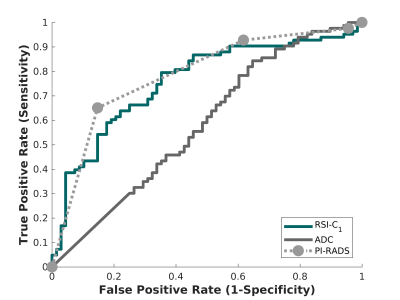 |
Automated patient-level detection of grade group ≥2 prostate cancer using quantitative restriction spectrum imaging MRI
Allison Y Zhong1, Leonardino A Digma1, Troy Hussain1, Christine H Feng1, Christopher C Conlin2, Karen Tye1, Asona J Lui1, Maren MS Andreassen3, Ana E Rodríguez-Soto2, Roshan Karunamuni1, Joshua Kuperman2, Rebecca Rakow-Penner2, Michael E Hahn2,
Anders M Dale2,4, and Tyler M Seibert1,2,5
1Department of Radiation Medicine and Applied Sciences, University of California San Diego, La Jolla, CA, United States, 2Department of Radiology, University of California San Diego, La Jolla, CA, United States, 3Department of Circulation and Medical Imaging, Norwegian University of Science and Technology, Trondheim, Norway, 4Department of Neurosciences, University of California San Diego, La Jolla, CA, United States, 5Department of Bioengineering, University of California San Diego, La Jolla, CA, United States
Multiparametric MRI (mpMRI) improves prostate cancer diagnosis, but conventional apparent diffusion coefficient (ADC) and PI-RADS have poor reliability. We evaluated restriction spectrum imaging MRI (RSI-MRI) as a quantitative, patient-level classifier of higher-grade prostate cancer (grade group ≥2) and compared performance to conventional ADC and PI-RADS. Area under the receiver operating characteristic curve values for ADC, RSI-C1, and PI-RADS were 0.58 [0.51,0.67], 0.76 [0.68,0.83], and 0.78 [0.71,0.85], respectively. RSI-C1 was superior to ADC (p=0.003) as a patient-level classifier of higher-grade prostate cancer. Performance of RSI-C1 was comparable to that of PI-RADS (p=0.59).
|
|||
4091.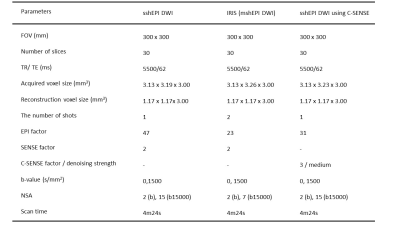 |
Comparison of single-shot EPI DWI, multi-shot EPI DWI, and single-shot EPI DWI using Compressed SENSE framework in prostate
Ayumu kido1, Tsutomu Tamada1, Yu Ueda2, Masami Yoneyama2, Jaladhar Neelavalli3, and Akira Yamamoto1
1Kawasaki Medical School, Okayama, Japan, 2Philips Japan, Tokyo, Japan, 3Philips India, Bangalore, India
Single-shot EPI (sshEPI) DWI still suffers from distortion and blurring. Multi-shot EPI (mshEPI) DWI called IRIS and sshEPI DWI using C-SENSE (a combination of parallel imaging and compressed sensing) enables to reduce distortion and blurring. A total of 14 prostate cancer (PC) patients underwent mpMRI including sshEPI DWI, IRIS, and sshEPI DWI using C-SENSE under the same scan time. The sshEPI DWI has comparable the diagnostic performance of PC equivalent to sshEPI DWI using C-SENSE and IRIS, whereas sshEPI DWI using C-SENSE and IRIS improve the image distortion and image blurring compared to sshEPI DWI.
|
|||
4092. |
Clinical application of single-shot echo-planer diffusion-weighted imaging with compressed SENSE in prostate MRI
Ayumu Kido1, Tsutomu Tamada1, Yu Ueda2, Masami Yoneyama2, and Akira Yamamoto1
1Radiology, Kawasaki Medical School, Okayama, Japan, 2Phillips Japan, Tokyo, Japan
Image quality of DWI with single-shot echo-planar imaging (ssEPI) suffers from low SNR in high b-value acquisition. Compressed SENSE (C-SENSE) allow for a reduction of the noise. A total of 26 patients with prostate cancer (PC) underwent mpMRI including DWI with ssEPI and SENSE (EPIS) and DWI with ssEPI and C-SENSE (EPICS). SNR was significantly higher in EPICS than in EPIS. In comparison between ADC of clinically significant PC and ADC of clinically insignificant PC, only EPICS had significant difference. Compared with EPIS, EPICS improves the image quality and may contribute to increased diagnostic performance of tumor aggressiveness in PC.
|
|||
4093.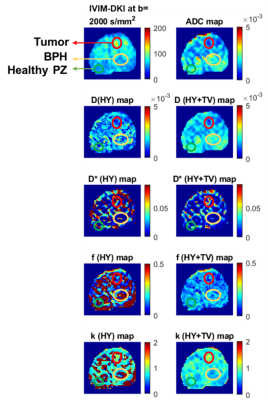 |
Characterization of prostate cancer and benign prostatic hyperplasia using IVIM-DKI with parameter-reconstruction method
Archana Vadiraj Malagi1, Virender Kumar2, Kedar Khare3, Chandan J. Das4, and Amit Mehndiratta1,5
1Centre for Biomedical Engineering, Indian Institute of Technology Delhi, New Delhi, India, 2Department of Nuclear Magnetic Resonance (NMR),, All India Institute of Medical Sciences Delhi, New Delhi, India, 3Department of Physics, Indian Institute of Technology Delhi, New Delhi, India, 4Department of Radiodiagnosis, All India Institute of Medical Sciences Delhi, New Delhi, India, 5Department of Biomedical Engineering, All India Institute of Medical Sciences Delhi, New Delhi, India
IVIM-DKI was used to evaluate clinical utility and diagnostic performance of IVIM-DKI parameters in characterization of prostate cancer(PCa) against benign prostatic hyperplasia(BPH) and healthy tissues. Sixteen patients suffering from PCa and BPH were recruited and underwent IVIM-DKI with routine MR sequences and biopsy. IVIM-DKI signal was modelled using hybrid model with total variation (TV) penalty function which removes any spurious values in parameters adaptively. HY with TV method produced high diagnostic performance (AUC:D=0.94-0.98, f=0.82-0.85 and k=0.85-0.91) than HY method for all tissues and high-quality parameter maps. IVIM-DKI parameters (D,f,k) showed significant differences between tumor and BPH and healthy tissue.
|
|||
4094.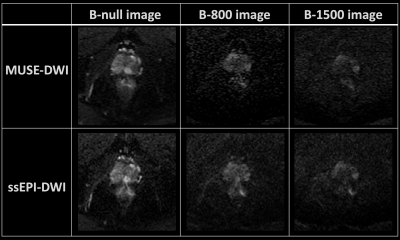 |
Comparison of multiplexed sensitivity encoding (MUSE) and single-shot echo-planar imaging (ssEPI) for diffusion-weighted imaging of prostate
Chun-Ying Shen1, Chia-Wei Li2, Chien-Yuan Lin2, and Ching-Hua Yang1
1Department of Radiology, Taovuan General Hospital, Ministry of Health and Welfare, Taovuan, Taiwan, 2GE Healthcare, Taipei, Taiwan
This study aimed to evaluate and compare quantitatively the effect of image distortion of multiplexed sensitivity encoding (MUSE) and conventional single-shot echo-planar imaging (ssEPI) for diffusion-weighted imaging (DWI) of the prostate. Our result showed that prostate images by MUSE-DWI can provide significant less distortions and higher SNR than that by conventional ssEPI-DWI at the similar acquisition time.
|
|||
4095.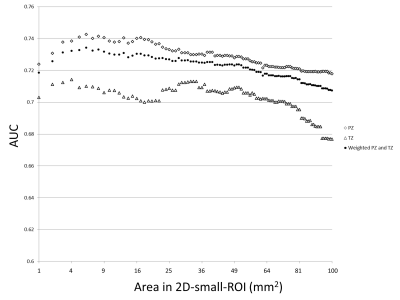 |
Optimal 2D-ROI Method to Measure Apparent Diffusion Coefficient of Lesions in Prostate MRI
Hiroaki Takahashi1, Kotaro Yoshida2, Akira Kawashima3, Num Ju Lee4, Adam T Froemming4, Daniel A Adamo4, Ashish Khandelwal4, Candice W Bolan5, Matthew T Heller6, Robert P Hartman4, Bohyun Kim4, Kenneth A Philbrick4, Rickey E Carter5,
Lance A Mynderse4, Mitchell R Humphreys6, and Naoki Takahashi4
1Department of Radiology, Mayo Clinic, Rochester, Rochester, MN, United States, 2Department of Diagnostic Radiology, Kanazawa University School of Medical Science, Kanazawa, Japan, 3Department of Radiology, Mayo Clinic, Arizona, Scottsdale, AZ, United States, 4Mayo Clinic, Rochester, Rochester, MN, United States, 5Mayo Clinic, Florida, Jacksonville, FL, United States, 6Mayo Clinic, Arizona, Scottsdale, AZ, United States
This study evaluated different 2D-ROI methods to measure ADC of prostate lesions on prostate MR. The optimal method for measuring ADC values of suspected lesion for differentiating csPCa and non-csPCa on prostate MRI is 2D-ROI method placed on the lowest ADC area using 6-8 mm2 / 8-9 pixel-size ROI (AUC, peripheral zone lesions: 0.740-0.743 / 0.742-0.743, transition zone lesions: 0.709-0.710 / 0.711-0.713). Use of a standardized ROI size improves interobsever variability.
|
|||
4096.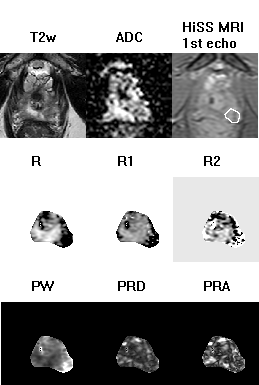 |
Application of High Spectral and Spatial resolution (HiSS) MRI in prostate: a pilot study
Milica Medved1,2, Aritrick Chatterjee1,2, Ajit Devaraj3, Carla Harmath1, Grace Lee1, Ambereen Yousuf1,2, Tatjana Antic4, Aytekin Oto1,2, and Gregory S Karczmar1,2
1Radiology, The University of Chicago, Chicago, IL, United States, 2Sanford J. Grossman Center of Excellence in Prostate Imaging and Image Guided Therapy, The University of Chicago, Chicago, IL, United States, 3Philips Research NA, Cambridge, MA, United States, 4Pathology, The University of Chicago, Chicago, IL, United States
HiSS MRI is an echo-planar spectroscopic imaging (EPSI)-based method focusing on the shape and structure of the water and fat resonances. In the prostate, temporal signal decay parameters (ROC AUC 0.74-0.91) and spectral resonance shape parameters (ROC AUC 0.83-0.91) show high diagnostic potential. Spectral shape parameters do not correlate strongly with temporal decay parameters. Thus, they carry information complementary to the standard clinical multi-parametric MRI and can likely be utilized to improve its diagnostic performance in prostate cancer.
|
|||
4097.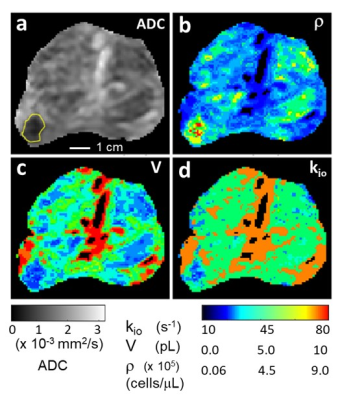 |
Non-Invasive Prostate Metabolic and Cytometric Imaging: Insights from Activity MRI [aMRI]
Xin Li1, Eric M. Baker1, Brendan Moloney1, Ryan P. Kopp2, Fergus V. Coakley3, Mark G. Garzotto4, and Charles S. Springer1
1Advanced Imaging Research Center, Oregon Health & Science University, Portland, OR, United States, 2Urology, Oregon Health & Science University, Portland, OR, United States, 3Radiology, Oregon Health & Science University, Portland, OR, United States, 4Urology, Portland VA Center, Portland, OR, United States
The first aMRI [activity MRI] parametric maps of malignant prostate are presented. They show the differences in cell density [r (cells/μL)], average cell volume [V (pL)], and on-going metabolic activity across the prostate. Metabolic activity is represented by the mean steady-state cellular water efflux rate constant [kio (s-1)], which reflects homeostatic cytolemmal Na+,K+-ATPase [NKA] enzymatic turnover [fmol(ATP)consumed/s/cell]. In a known Gleason (3 + 4) tumor, r is
increased, while V and kio are decreased – relative to normal-appearing tissue. Such changes are sensible, and these new biomarkers may be diagnostic and/or predictive.
|
|||
4098.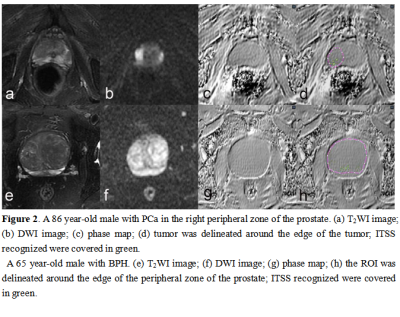 |
Differential diagnosis of PCa and BPH using intratumoral susceptibility signal intensities based onESWAN
Yunsong Liu1, Hongkai Wang2, Mingrui Zhuang2, Lihua Chen1, Qingwei Song1, Shuang Meng1, and Ailian Liu1
1The First Affiliated Hospital of Dalian Medical University, Dalian, China, 2Dalian University of Technology, Dalian, China
It remains a challenge to diagnose differentiate PCa from BPH due to their similar clinical symptoms. The aim of this study was to evaluate the value of intratumoral susceptibility signal intensities (ITSS) in differentiating PCa and BPH based on enhanced T2 star-weighted angiography (ESWAN). The diagnostic efficiency was promising well in quantitatively and automatically differentiation of PCa from BPH by ITSS based on ESWAN.
|
|||
4099. |
Physically Implausible Diffusion Signals (PIDS) as a Quality Assessment Metric in Prostate DWI
Teodora Szasz1, Milica Medved2, Aritrick Chatterjee2, Ajit Devaraj3, Ambereen Yousuf2, Xiaobing Fan2, Gregory Karczmar2, Aytekin Oto2, and Grace Lee2
1Research Computing Center, The University of Chicago, Chicago, IL, United States, 2Department of Radiology, The University of Chicago, Chicago, IL, United States, 3Philips Research North America, Chicago, IL, United States
Diffusion weighted imaging (DWI) is important for prostate cancer diagnosis but is highly sensitive to artifacts. We developed a method for automatically and quantitatively measuring physically implausible DWI signals (PIDS) that could contribute to diagnostic errors. The level of PIDS is significant and similar in all prostate zones, for scans both with and without an endorectal coil, and is strongly correlated with motion. For scans without the endorectal coil, PIDS is correlated with noise level. In regions with a high percentage of PIDS, PIRADS II criteria may not be optimal, and algorithms that emphasize T2 and DCE-MRI may be preferable.
|
|||
4100. |
POST-ACQUISITION WATER SIGNAL REMOVAL IN 3D WATER-UNSUPPRESSED 1H-MR SPECTROSCOPIC IMAGING DATA OF THE PROSTATE
Angeliki Stamatelatou1, Diana Sima2, Sabine Van Huffel3, Sjaak Van Asten4, Arend Heerschap4, and Tom Scheenen4
1Radiology, Radboud UMC, Nijmegen, Netherlands, 2Icometrix, Leuven, Belgium, 3KU Leuven, Leuven, Belgium, 4Radboud UMC, Nijmegen, Netherlands
Water-unsuppressed MRSI acquisitions could obliviate the need for additional reference data sampling for signal quantification. We evaluated two methods for post-acquisition water signal removal in 1H-MRSI of the prostate. The method using Löwner Blind Source Separation for filtering the water signal outperformed the matrix-based Hankel Lanczos Singular Value Decomposition method. The two techniques were evaluated and compared against conventional water suppressed data acquisitions in 4 volunteers. The results demonstrate that post-acquisition water removal was successfully implemented in water-unsuppressed prostate MRS(I) data, and that the Löwner filter showed the best performance.
|
|||
4101.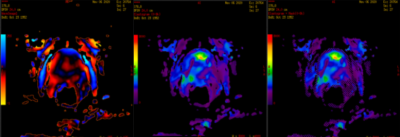 |
Standardization of SE-MRE at 3.0T for the prostate.
Nicolás Moyano Brandi1,2,3, Daniel Fino1,2,4, Joaquín Capó1,2,3, Federico González1,4,5, Bruno Lima1,2, Maximiliano Noceti1,2,6, Pablo Ariza1,2, and Andrés Dominguez1,2
1Magnetic Resonance, Fundacion Escuela de Medicina Nuclear, Mendoza, Argentina, 2Magnetic Resonance, Fundación Argentina para el Desarrollo en Salud, Mendoza, Argentina, 3Universidad de Mendoza, Mendoza, Argentina, 4Universidad Nacional de Cuyo, Mendoza, Argentina, 5Comisión Nacional de Energía Atómica, Mendoza, Argentina, 6Hospital Italiano, Mendoza, Argentina
MRE generates quantitative information of shear modulus. Several challenges exist for the assessment of prostate. Difficulties with wave propagation due to the central location of the prostate, have induced the development of different techniques including transurethral and endorectal drivers. The objectives of this work were to study the 3.0 Tesla trans-pelvic MRE performance in PCa at a standard excitation frequency (⍵) of 60 Hz, as well as the reproducibility of µ at different ⍵ values. In 43 patients, the MRE were acquired using five 2D-SE sequences (⍵ values: 40, 50, 60, 70 and 80 Hz) and GRE 2D sequences
|
|||
4102.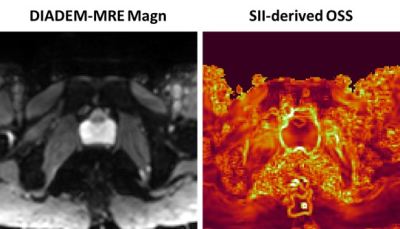 |
Development of Distortion-Free MR Elastography Methods for Slip Interface Imaging of the Prostate
Yi Sui1, Kay Pepin1, Phillip J. Rossman1, Kevin Glaser1, Lance Mynderse2, Richard L. Ehman1, and Ziying Yin1
1Radiology, Mayo Clinic, Rochester, MN, United States, 2Urology, Mayo Clinic, Rochester, MN, United States
Slip interface imaging is a MR elastography based technique that enables assessing the mechanical connectivity between the tumor and its sourronding tissues. In this study, we have implemented a distortion-free MRE method (DIADEM-MRE) for detecting slip boundary of the prostate capsule. This technique has the great potential to be used to locate the margin of tumor adherent to the prostatic capsule, thus predicting the present of extraprostatice extension of prostate cancer.
|
|||
4103.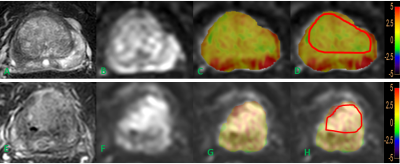 |
Investigate the correlation between APT valuesand ADCs in Benign Prostatic Hyperplasia and Prostatic Cancer
Shuang Li1, Ailian Liu1, Lihua Chen1, Yuanfei Li1, Shuang Meng1, Jiazheng Wang2, Peng Sun2, Qingwei Song1, and Renwang Pu1
1The First Affiliated Hospital of Dalian Medical University, Dalian, Dalian, China, 2Philips Healthcare, Beijing, China, Beijing, China
Differential diagnosis of benign prostatic hyperplasia (BPH) and prostatic cancer (PCa) now mainly depends on the results of the pathology. Both amide proton transfer-weighted (APTw) and diffusion-weighted imaging (DWI) are promising non-invasive methods to classify BPH and PCa. In this study, we explore the correlation between the APT values and ADC derived from DWI in BPH and PCa. The results indicate the APT values showa moderate negative correlation with ADC, which confirms both methods are effective in the differential diagnosis of BPH and PCa.
|
|||
4104.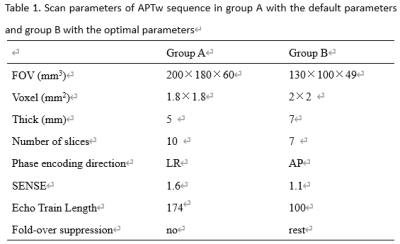 |
Optimization of 3D prostate APTw MR imaging
Wenjun HU1, Ailian Liu1, Lihua Chen1, Zhiwei Shen2, Jiazheng Wang3, Yi Zhang4, and Qingwei Song1
1The First Affiliated Hospital of Dalian Medical University, Dalian, China, 2Philips Healthcare, Beijing, China, 3Philips Healthcare, Bejing, China, 4Zhejiang University, Hangzhou, China
Recently, prostate disease prevalence has been shown to increase gradually. Amide proton transfer-weighted (APTw) imaging, a molecular MRI technique at the protein level, has been applied in the diagnosis of prostate disease. This study aims to explore the optimal scan parameters for prostate APTw MR imaging. The preliminary results showed higher SNR of APTw images in central zones was acquired with the optimal scan parameters including the echo train length, the numbers and thickness of slices, FOV, the type of fold-over suppression and shimming, the size of voxel and phase encoding direction.
|
The International Society for Magnetic Resonance in Medicine is accredited by the Accreditation Council for Continuing Medical Education to provide continuing medical education for physicians.